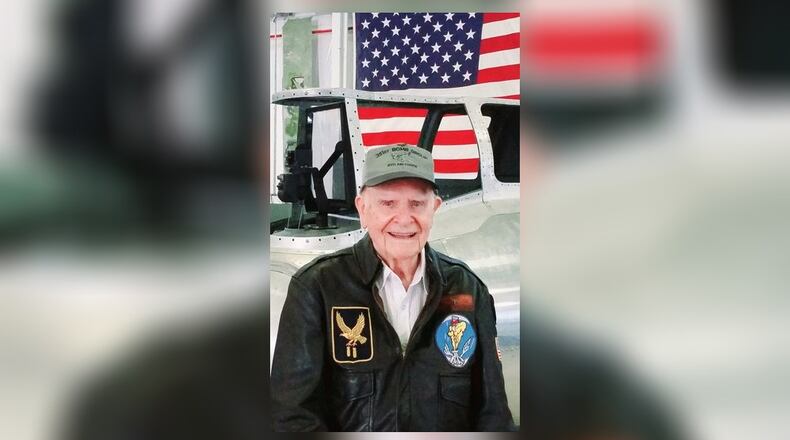Kemp is a true “Master of the Air,” with 35 combat missions to his credit along with the Distinguished Flying Cross, an Air Medal with Silver Oak Leaf Cluster and the European African-Middle Eastern Campaign Medal with a silver star.
Kemp turned 100 Friday and he plans to mark it with yet another flight into the wild blue yonder. The former Tail Gunner and Left Waist Gunner sounded thrilled as a 10-year-old about the prospect of flying on a jet plane.
“I’ve never flown in a jet airplane in my life,” Kemp says. He’s more of a B-17 and Cessna guy, but he’s looking forward to the speed the jet he’s scheduled to take to the air can achieve - up to 500 mph he says with excitement.
Kemp could qualify as the lead character of a movie based on his own life, and it would be breathtaking to see.
Kemp was drafted into World War II at the age of 19, eventually serving with the 351st Bomb Group out of Polebrook, England. He was involved in advance training at the British base when the Normandy Invasion began on June 6, 1944.
“We were on base when we saw lots of planes overhead and knew something was happening,” he recalls. His squadron soon joined in the campaign. His flew his first mission on a bombing run to Berlin, Germany on June 21, 1944. It was a 9 and a half hour flight to reach the targeted city, one of many extended flights Kemp would log in his wartime service.
During his third mission, on the coastline of France, the plane was being hit by rounds of flak, some of it damaging the cables of the plane and several rounds striking directly under the pilot’s seat.
“It came through the floor and directly up, hitting the pilot and moving directly from the ankle through the kneecap,” Art remembers. “He was bleeding badly and the co-pilot took over. Despite never before landing a B-17 in combat, the co-pilot issued an intercom announcement saying “Don’t worry boys, I’ll get you home.”
A five hour flight followed, with the pilot reviving just before landing to take over the controls and set the plane safely down. Medics rushed to the plane to provide care to the pilot, who was not removed from the plane until he was stabilized, 45 minutes later. Unfortunately, his leg required amputation, but he did survive.
Kemp earned designation as the lead tail gunner, a role accorded him more safety along with special responsibility for operating the signal light to communicate with other bombers following behind the lead bomber. He would use Morse code to flash squadron identification so planes would fall in line, and keep the pilot informed on the location of all the planes in the squadron.
During one wartime bombing mission, the crew had successfully dropped their bomb load and headed back to base when they encountered a Focke-Wulf German fighter and began taking fire. The B-17′s engine and ball turret were hit, a gunner killed. The tail section around Kemp’s position suffered multiple shots, all of them missing Kemp. As the German plane came around to finish off the severely damaged plane, Kemp fired from his tail gunner position and hit the Focke-Wulf, which began plummeting toward the ground. The pilot ejected and his parachute failed to open.
Within minutes, the badly damaged plane was targeted again by a Messerschmitt fighter plane. As it maneuvered for position to fire, Kemp saw his opportunity and fired his machine gun again, striking and destroying his second German fighter plane on a single mission.
Kemp survived all of his war adventures, and returned to the states to serve as an Air Force training instructor for pilots before returning home to Ohio in 1945. He entered the tool and dye trade, and admits that when he got out of the service at the age of 21, he was “still kinda wild.” After experiencing three auto accidents within 6 months, he reasoned that “if this keeps on I won’t live to 22.”
Fortunately he did, and his 1954 marriage helped further settle him down. He and his wife enjoyed 63 years together before she passed away seven years ago.
But he has never given up the joy of flight.
He earned his pilots license in 1948 and bought a Cessna 150, which he flew for 19 years for pleasure, including taking to the the air every day for the first month following his 1969 retirement from Siemens Industry in Bellefontaine.
He earned a reputation among other area pilots as “the guy who can fly anywhere.”
In more recent years, he has dedicated much of his time to volunteering at Urbana’s Champaign Aviation Museum. He regularly makes the 16 mile drive from his home to the museum, where he enjoys continued conversations with other veterans and pilots about his favorite topics - airplanes and flight.
Kemp’s real life experience qualifies him as one of the legendary “Masters of the Air,” and he continues to climb sunward on silver wings whenever the opportunity presents - even at 100 years of age.
About the Author
